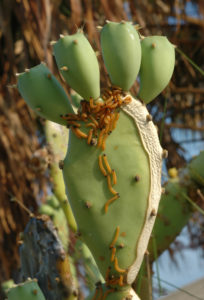Cactus moths from South America were first confirmed in Texas in 2017 in the upper coastal area of the state: Brazoria, Chambers, Colorado and Matagorda counties. Texas A&M AgriLife Extension Service program specialist Wizzie Brown says insect experts are asking everyone in the state to keep an eye out to try to curb their damaging spread.
The problem:
Cactus moth larvae live in and feed on the cactus pads. They can destroy entire stands of cactus. That’s a problem for folks who like the look of them in their yards but even more so for people who grow prickly pear as a food crop.
“You can kind of see the damage and they will become translucent where the inside of that cactus pad has been eaten away. So if you see kind of mottled light brown patches on the prickly pear, take a closer look at it. You might want to break that pad open because the larvae are going to actually be inside of that pad.”
 Spotting a cactus moth in its various forms:
Spotting a cactus moth in its various forms:
The moth: “A small to medium-sized moth. They’re kind of a mottled brown color.”
They look a lot like many other moths you might see on cactus – so you’ll need to catch a sample or get good, clear pictures to send to an entomologist to confirm.
 The larvae: Again, this is the form of the moth that does the damage.
The larvae: Again, this is the form of the moth that does the damage.
“A reddish orange color and they have these black dots. And depending on the age of the larvae, those dots may be really close together and make it look like they have solid stripes on them. But then, as the larvae mature, the dots spread out and then they just have these dots that are going across the body all the way down.”
The eggs: “They are made in these long chains by the moth and so they almost look like spines coming off of the cactus pads. But the big difference here is if you see kind of wonky-looking spines on your prickly pear, you might want to take a closer look because these egg chains or the egg sticks are curved in shape. They’re not straight like regular cactus spines. So if you see some weird looking spines on your cactus, definitely go take a closer look at it.”
To eradicate:
Experts are doing tests to try to determine if there are effective pesticides to use for cactus moths. Right now, the recommended method is simple elimination of infected cactus:
“By removing the infested cactus manually or removing the egg sticks that are found if you catch it early enough in the egg stage.”
For help identifying:
You can send samples or photos of cactus moths to Wizzie Brown.
There’s also a Texas Department of Agriculture Plant Quality program. You can email PlantQuality@TexasAgriculture.gov or call 512-463-7660.
Something else bugging you? Give us a buzz and we’ll pass your question along.














